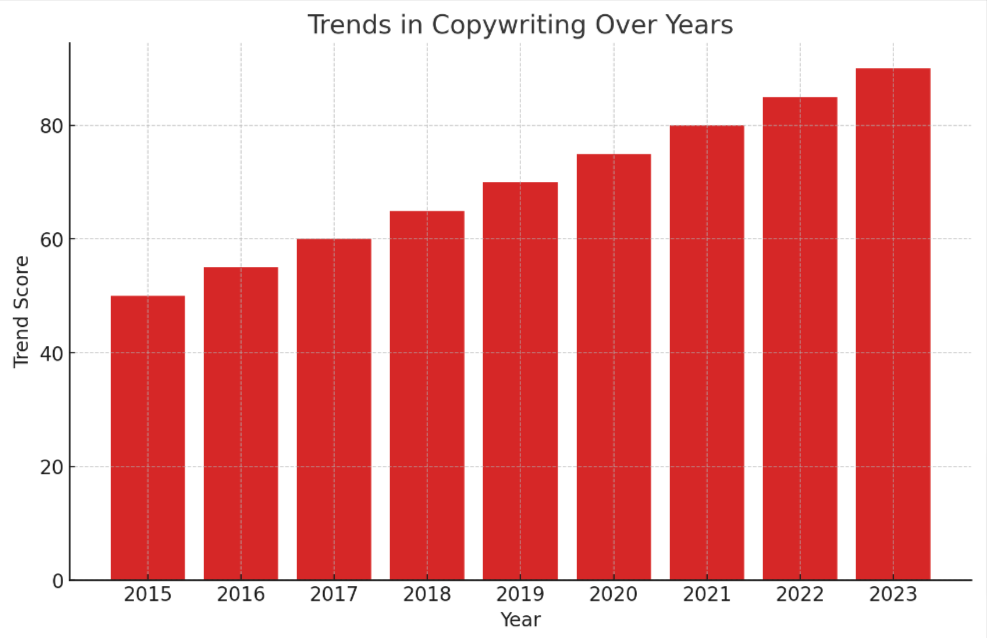Mastering Copywriting Skills for Marketing and Advertising Success
Struggling to grab attention with your words? Effective copywriting can skyrocket your marketing and advertising efforts. This post unpacks the secrets of crafting compelling content that captivates and converts.
Stay tuned for the magic of words!
Key Takeaways
- Effective copywriting captures attention and persuades people to take action, like buying a product or signing up for a service.
- Marketing copywriters must use storytelling, focus on benefits, include calls to action, and understand the needs of their target audience to create content that sells.
- Various frameworks such as SB7, AIDA, Problem-Solution, and Before-After-Bridge help structure compelling marketing messages.
- Tailored copy for different stages of the customer journey and specific platforms like social media and landing pages is essential in addressing the customer effectively.
- Staying updated with trends and adapting to new technologies like AI are critical for future success in marketing copywriting.
Understanding Copywriting for Marketing and Advertising
Copywriting is the art of creating compelling messaging that persuades the target audience to take action. Marketing copywriters play a crucial role in crafting content that effectively promotes products, services, or ideas to drive sales and brand recognition.
Definition of copywriting
Copywriting is the craft of writing text for marketing and advertising purposes. This type of writing aims to persuade people to take an action, such as buying a product or signing up for a service.
It’s all about creating compelling messages that speak directly to the target audience, grabbing their attention and convincing them of the value being offered.
Great copy uses persuasive writing techniques combined with brand storytelling to create a connection with readers. A skilled marketing copywriter knows how to weave words in a way that both informs and engages, driving sales and promoting branding.
With every campaign comes the need for fresh, promotional writing that stands out and gets people talking—and most importantly—acting on the call to action. Moving from defining what copywriting is, let’s delve into the role of a marketing copywriter in shaping powerful messaging strategies.
Role of a marketing copywriter
Understanding what copywriting entails sets the stage for revealing the dynamic role of a marketing copywriter. These creative professionals craft compelling messaging that grabs attention, engages audiences, and drives them to take action.
They use persuasive writing techniques to highlight a product’s benefits, stir emotions, and weave brand storytelling into content that resonates with the target audience.
A marketing copywriter must tailor their approach for various forms of advertising copy – from punchy social media posts to detailed sales pages. Each piece aims to reflect the brand’s voice while promoting products or services effectively.
They often end with a strong call to action, pushing readers towards a purchase or another desired outcome such as subscribing or sharing information. In essence, they don’t just write; they strategize ways to turn words into revenue by mastering the art of persuasion in advertising and promotion efforts.
Importance of good copy in marketing
As a marketing copywriter crafts the message, good copy acts as the bridge connecting products to consumers. It’s what turns interest into action. By using compelling messaging and persuasive writing, effective copy captures attention and speaks directly to the needs and desires of the target audience.
This kind of communication is critical in guiding potential customers through their journey from awareness to consideration, and finally, to making a purchase.
In today’s fast-paced digital world, where countless brands vie for attention, standout copy can be what sets a brand apart. Good marketing copy engages readers with storytelling that resonates, prompting them not just to listen but also to act—whether by subscribing, sharing content or buying a product.
Strong calls-to-action within your sales pages motivate immediate responses while simultaneously building lasting relationships with your audience—a key goal for any promotional writing endeavor.
Frameworks for Writing Effective Marketing Copy
Explore the different frameworks like SB7, AIDA, Problem-Solution, and Before-After-Bridge (B.A.B) for crafting compelling marketing copy that resonates with your target audience and drives action.
Understanding these frameworks will help you create high-converting content for your advertising and promotional efforts.
SB7 Framework
The SB7 framework is a powerful tool for crafting effective marketing copy. This framework focuses on seven key elements that help create compelling messaging and engage the target audience. It ensures that the copy is structured to grab attention and drive action.
- Storytelling: The SB7 framework emphasizes the importance of incorporating brand storytelling into the copy to connect with the audience on a personal level, building an emotional connection.
- Solution-oriented: It centers around presenting the product or service as a solution to the target audience’s pain points, showcasing its benefits and value.
- Benefits-focused: The framework highlights the need to communicate the specific benefits of the product or service, addressing what sets it apart and how it meets customers’ needs.
- Social proof: Incorporating social proof such as testimonials, reviews, or case studies establishes credibility and reinforces trust in the offering.
- Call to action (CTA): The SB7 framework emphasizes crafting a strong and clear call to action that prompts the audience to take the desired action, whether making a purchase or signing up for more information.
- Audience-centric: It stresses understanding and speaking directly to the target audience’s needs, desires, and pain points, ensuring that the copy resonates with them.
- Engaging language: Using compelling and persuasive language throughout the copy is essential in capturing attention and maintaining audience engagement.
AIDA Framework
The AIDA framework is a key tool for creating effective marketing copy. It stands for Attention, Interest, Desire, and Action. This framework guides copywriters to grab the audience’s attention, generate interest in the product or service, create desire for it, and prompt action from the reader.
- Attention: The first step is capturing the audience’s attention with a compelling headline or opening statement that addresses their needs or pain points.
- Interest: Once attention is captured, maintain it by highlighting the benefits of your product or service and how it solves the audience’s problems.
- Desire: Build desire by painting a vivid picture of how the product or service can improve the audience’s life or situation.
- Action: Prompt action with a clear call-to-action that tells the audience what to do next, whether it’s making a purchase, signing up for a newsletter, or contacting your business.
Problem-Solution Framework
The problem-solution framework is a strategy that focuses on addressing the pain points and challenges of the target audience. It aims to provide solutions and position the product or service as the remedy. This framework follows a structured approach to effectively communicate with the audience by:
- Identifying the specific problem or pain point that resonates with the target audience, using empathetic and relatable language.
- Presenting the product or service as the ideal solution to alleviate the identified problem, highlighting its unique value proposition and benefits.
- Showcasing social proof, testimonials, or case studies to build credibility and reassure the audience about the effectiveness of the solution.
- Concluding with a strong call to action that prompts immediate action from the audience, encouraging them to embrace the offered solution.
Before-After-Bridge (B.A.B) Framework
The Before-After-Bridge (B.A.B) Framework is an effective method for structuring persuasive marketing copy. It involves setting the scene with the “before” scenario, painting a picture of the transformation with the “after” scenario, and then bridging the two with your product or service as the solution.
- Start by vividly describing the current situation or problem your target audience faces.
- Paint a compelling image of what their life could be like after using your product or service.
- Bridge the before and after by showing how your offering can lead to this transformation.
Writing Copy for Different Stages and Platforms
Create tailored copy for different stages of the customer journey, including top, middle, and bottom of funnel content. Additionally, understand how to craft effective copy for various platforms such as landing pages, social media, search engine, email, and SMS/push notifications.
Top, middle, and bottom of funnel copy
Crafting copy for different stages of the marketing funnel requires tailored messaging to effectively engage and convert prospects. Each stage serves a specific purpose in guiding the customer towards a purchase decision.
- Top of funnel copy introduces the audience to the brand and its products or services. It aims to create awareness and capture attention by addressing pain points and offering solutions, using compelling storytelling and engaging content that resonates with the target audience’s needs.
- Middle of funnel copy nurtures leads by providing valuable information, building trust, and showcasing the brand’s expertise. It focuses on educating prospects about the benefits of the products or services, highlighting unique selling points, and influencing consideration through persuasive messaging that addresses specific pain points and objections.
- Bottom of funnel copy aims to convert leads into customers by leveraging persuasive language, strong calls-to-action, and compelling offers. It emphasizes urgency, social proof, and reassurance to prompt immediate action while overcoming any remaining objections or hesitations that may prevent a purchase decision.
Landing page, social media, search engine, email, and SMS/push notification copy
To create effective copy for various marketing platforms, it is crucial to tailor the messaging to suit the specific nature of each platform. Here are some guidelines for crafting compelling copy across different marketing channels:
- Landing Page Copy:
- Social Media Copy:
- Search Engine Copy:
- Email Copy:
- SMS/Push Notification Copy:
Becoming a Successful Marketing Copywriter
Education and internships play a crucial role in shaping the skills of a marketing copywriter, along with the ability to effectively communicate and adapt to the latest marketing trends.
The future of copywriting is also evolving with AI technology, making it essential for aspiring copywriters to stay updated with these advancements.
Education and internships
To excel as a marketing copywriter, pursuing a relevant degree in communications, marketing, or journalism would be advantageous. Many employers also value internships that provide hands-on experience in crafting compelling messaging for different platforms and target audiences.
Additionally, gaining practical knowledge through internships at advertising agencies or marketing departments can contribute significantly to building a solid foundation as a successful marketing copywriter.
Understanding the dynamics of the industry and honing persuasive writing skills through real-world projects during internships can set the stage for a thriving career in marketing and advertising copywriting.
Communication skills
Good communication skills are essential for a marketing copywriter. Clarity and precision in conveying ideas help ensure that the message resonates with the audience. A strong grasp of language, including grammar and vocabulary, is crucial in crafting compelling and effective copy.
Furthermore, active listening and empathy enable copywriters to understand the needs and preferences of their target audience better, allowing them to tailor their messaging for maximum impact.
A marketing copywriter must be adept at adapting their tone and style to suit different platforms and audiences. Additionally, collaboration with other team members such as designers or digital marketers requires clear articulation of ideas to ensure everyone is aligned towards a common goal.
Staying updated with the latest marketing trends
Staying updated with the latest marketing trends is essential for marketing copywriters. Keeping abreast of shifts in consumer behavior, emerging technologies, and evolving best practices helps adapt messaging to changing audience preferences.
By staying current, copywriters can infuse their content with relevant industry insights and leverage new opportunities for engaging target audiences effectively.
Understanding the latest marketing trends enables copywriters to create compelling messaging that resonates with the ever-changing needs and desires of their target audience. Additionally, staying informed about new marketing techniques empowers them to craft persuasive content that aligns with current consumer behaviors and preferences.
Importance of brand voice
Crafting a unique and consistent brand voice is essential for creating a strong connection with the target audience. It helps in conveying the brand’s personality, values, and positioning in a way that resonates with the consumers.
A well-defined brand voice also sets a clear tone for all marketing communication, ensuring that every piece of content reflects the brand’s identity and messaging style, ultimately leading to increased recognition and trust among customers.
Moreover, establishing a distinct brand voice enables companies to differentiate themselves from competitors and create a memorable impression on their audience. By maintaining this consistency across various platforms and touchpoints, businesses can reinforce their brand image and build lasting relationships with customers based on familiarity and authenticity.
The future of copywriting with AI technology

AI technology is revolutionizing the field of copywriting, enabling marketers to create more personalized and targeted content. Marketers are utilizing AI-powered tools to analyze consumer data and behavior, allowing for the generation of highly relevant and compelling copy.
This advancement in technology also streamlines the process of creating different variations of copy tailored to specific audience segments, optimizing engagement and conversion rates across various marketing platforms.
Furthermore, AI algorithms can predict consumer preferences and trends, providing invaluable insights for crafting persuasive messaging that resonates with target audiences. As AI continues to evolve, it will undoubtedly play a pivotal role in shaping the future landscape of copywriting for marketing and advertising by enhancing efficiency, precision, and effectiveness in crafting compelling brand narratives and call-to-action messages.
Conclusion
In conclusion, mastering copywriting for marketing and advertising requires understanding the various frameworks for crafting persuasive content. Writing effective copy tailored to different stages and platforms is crucial.
Communication skills and staying current with marketing trends are key to becoming a successful marketing copywriter. The future of copywriting will undoubtedly be impacted by AI technology, emphasizing the need to adapt and innovate in this dynamic field.

